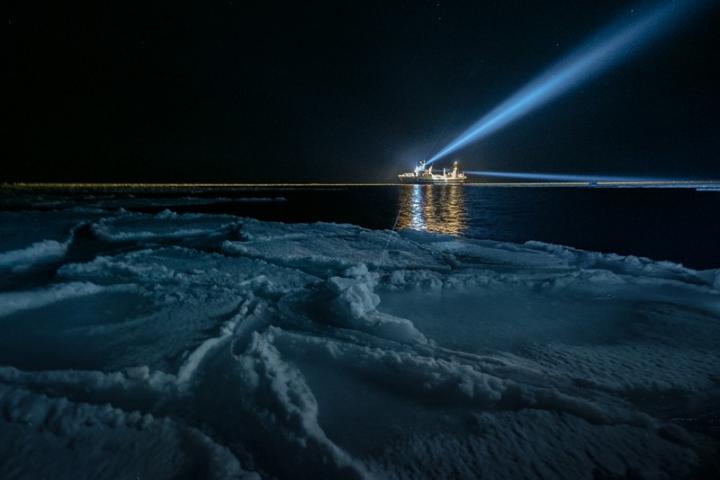Artificial light in the Arctic

UD Prof. Jonathan Cohen is a co-author of a new study looking at how artificial light during the polar night disrupts Arctic fish and zooplankton behavior down to 200 meters in depth, which could affect fish counts. Cohen said that research vessels during the Arctic polar night are like Christmas trees illuminated in the middle of the dark ocean. Photo by Michael O. Snyder
The Arctic polar night remains one of the last undisturbed dark environments on the planet. But as the climate changes and human activities increase in the Arctic, natural light sources — such as the moon, the stars and the aurora borealis — are being masked by much stronger illumination from artificial light.
University of Delaware Professor Jonathan Cohen has co-written a new study that looks at how artificial light during the polar night disrupts Arctic fish and zooplankton behavior down to 200 meters in depth. The disruption of species behavior so far down in the water column could introduce biases on stock assessments of commercial and non-commercial fish species.
These findings were recently published in the Communications Biology scientific journal.
Cohen, associate professor in UD's College of Earth, Ocean and Environment, said that research vessels during the Arctic polar night are like Christmas trees illuminated in the middle of the dark ocean.
“You're trying to measure and understand the position of animals in the water column, a process that's very light sensitive, and you're completely changing the light environment around you,” said Cohen. “In reality, it's completely impossible to understand the process from a lit-up research vessel because you're swamping the organisms and they're not doing what they would normally do.”
To counteract this process, Cohen and other researchers took acoustic surveys of fish and plankton in the water column directly below the lit-up research vessel and then also took surveys using autonomous surface vehicles without lights that were far away from the research vessel.
They found a lot more fish and plankton appearing in the water column underneath the autonomous surface vehicles when they compared the results to the number of fish they saw in the water column directly below the research vessel.
These findings were published in 2018 and for this subsequent study, the researchers wanted to quantify the animal avoidance response and the light field around the vessel in more detail.
“We made a series of measurements of light around the vessel, trying to get a sense of how far away from the vessel this response occurred with the ultimate goal of trying to understand what impact these artificial light fields would have for fisheries surveys conducted during the night time or during the polar night,” said Cohen.
It is important to have accurate fish surveys as fishery agencies across the world rely on acoustic surveys to help understand fish populations and then those population estimates ultimately influence catch quotas for fisheries management.
The concern raised in the paper is that artificial light production from fisheries survey vessels could influence the way that those population estimates are made.
“In the paper, we demonstrated that there's a sphere of light around the vessel that causes an influence, and we see it easily through the upper 200 meters of the water column,” said Cohen. “So the effect of artificial light isn't just limited to the surface. It goes down quite deep in terms of an avoidance of the organisms. They just go away and so you end up predicting the number of organisms to be a lot lower than you might expect.”
The acoustic surveys used in the study show the fish as little dots in the water column. When the researchers measured from the research vessel, the little dots in the water column underneath the boat moved away from the light field. But when the researchers took a surface vehicle or a small boat and went away from the vessel, the natural response came back and more fish appeared in the water column.
The biggest finding in the paper is that the response of fish species occurred so far down in the water column, as the effects of the ship's lights were evident in the fish species all the way down into the Mesopelagic Zone — or so-called Twilight Zone — of the ocean.
Cohen and the other researchers are hoping that these findings will help fishery managers think twice about how they are reporting fish populations in the ocean when they are using artificial light in the Arctic polar night, and elsewhere during the nighttime.
“We're basically trying to set the parameters to say if you have a vessel and you're looking at this portion of the water column, the values aren't going to be as useful,” said Cohen.
Media Contact
All latest news from the category: Earth Sciences
Earth Sciences (also referred to as Geosciences), which deals with basic issues surrounding our planet, plays a vital role in the area of energy and raw materials supply.
Earth Sciences comprises subjects such as geology, geography, geological informatics, paleontology, mineralogy, petrography, crystallography, geophysics, geodesy, glaciology, cartography, photogrammetry, meteorology and seismology, early-warning systems, earthquake research and polar research.
Newest articles

First-of-its-kind study uses remote sensing to monitor plastic debris in rivers and lakes
Remote sensing creates a cost-effective solution to monitoring plastic pollution. A first-of-its-kind study from researchers at the University of Minnesota Twin Cities shows how remote sensing can help monitor and…

Laser-based artificial neuron mimics nerve cell functions at lightning speed
With a processing speed a billion times faster than nature, chip-based laser neuron could help advance AI tasks such as pattern recognition and sequence prediction. Researchers have developed a laser-based…

Optimising the processing of plastic waste
Just one look in the yellow bin reveals a colourful jumble of different types of plastic. However, the purer and more uniform plastic waste is, the easier it is to…



